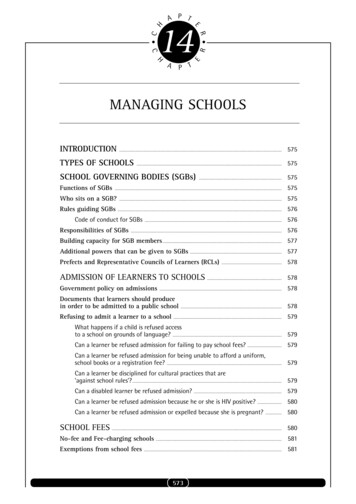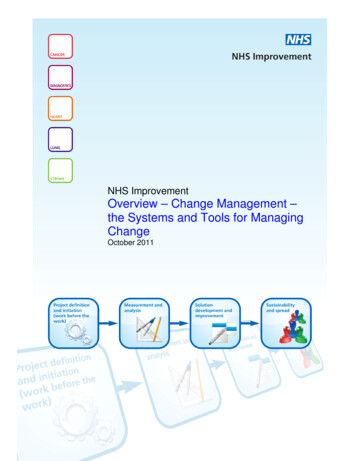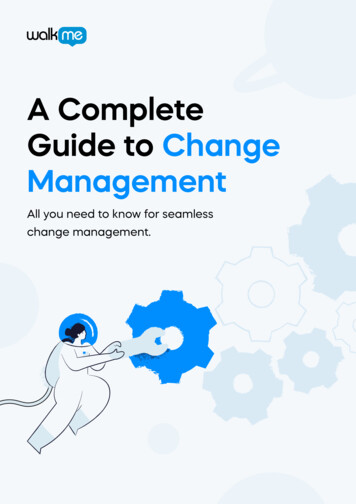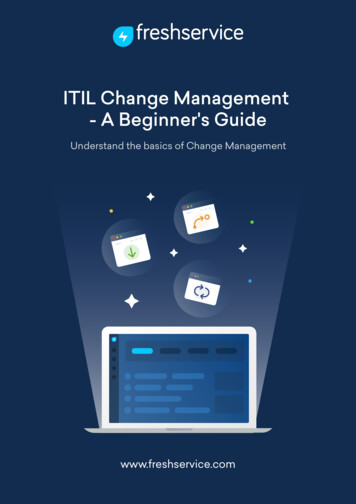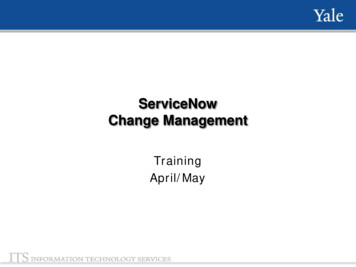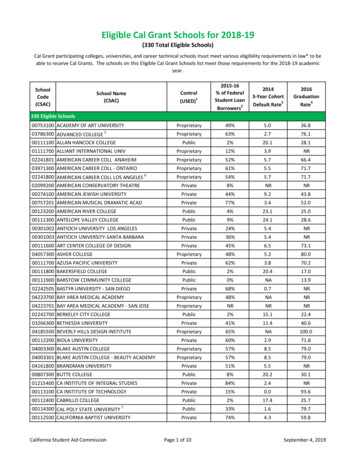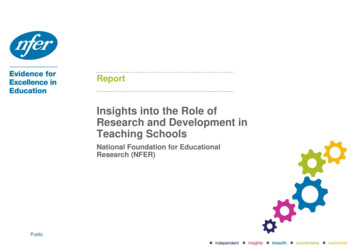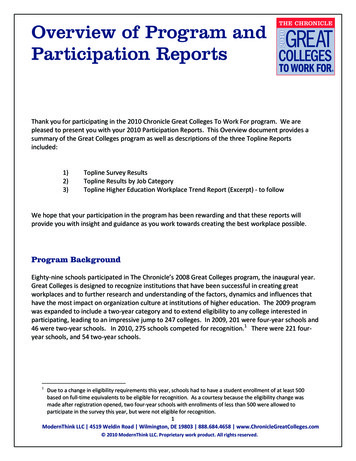
Transcription
ChangeManagementin SchoolsWhat the research tells us aboutimplementing successful innovationsA free resource made by ManageBac
Change is ChallengingHey, I’ve gotan idea!That’s brilliant,I’ll do it rightnow!I don’t get it.What I doalready worksfine for me.1 year laterI still think my ideawould work It does work! Whyaren’t we all doingit again?Every year,anotherleader with abig idea.Doing what?Change Management2
Evaluating thesuccess of aninnovationBefore embarking on a schoolimprovement effort, it is important toconsider how to ultimately evaluateits success. Miller and Bentley (2002)suggest that an innovation is successfulwhen it has become sustainable andinstitutionalised. This means it reachesa ‘tipping point’ at which the innovationbecomes a feature of the system as awhole. Glatter et al. (2005), on the otherhand, look at the impact of the innovationas a measure of success, and urge usto consider whether an innovation hasconsequences that are noteworthy, highlyvalued and relevant.Innovations should be evaluated both interms of their uptake and their impact onstudent learning outcomes.Change Management3
Why do mostinnovations inschools fail?The limited success of many changeefforts in schools is party due to theirorganisational structure. Schools are nottidy, efficient, coordinated structures.Instead, they comprise many suborganisations which can be added,removed or changed with very littleoverall effect on the organisation (Weick,1976). The internal stability of thesesub-organisations means school-wideinnovations often do not succeed atchanging practices within each silo.Plan for your innovation to succeedby setting realistic time frames,tailoring innovations to your schoolcontext, prioritising collaboration,and supporting those who arestruggling with change.Furthermore, as described by Fullan(2001), many change efforts fail dueto a lack of planning prior to thecommencement of an innovation, themisconception that off-the-shelf solutionswill work (as opposed to those whichtake cultural context into account),unrealistic or undefined timeframes, anda lack of sensitivity towards those whoare apparently rejecting or resisting thechange.AccountsEarlyYearsESLMathsScienceChange Management4
Theoretical modelsof the changeprocess in schoolsA number of theoretical models of thechange process have been proposed.Waks (2007), for example, suggeststhat the change process begins at theinstitutional level, the backgroundeducational ideas, norms and frameworksthat shape and regulate an organisation.An institutional change causes frustrationand protest, fuelling new ideas andinnovations, from which emerge newbeliefs, values and practices. Theorganisation then readjusts to the newinstitutional ideas and norms.Priestly & Miller (2012) made useof conceptual tools derived fromcritical realism to develop a greaterunderstanding of educational change.They differentiated between structure andculture in an attempt to distinguish thecontribution each makes to the changeprocess, and found that both culture(beliefs, values, norms and ideas) andstructure (relationships, resources, power,social positions) influence how teachersrespond to innovation.Spillane, Reiser and Reimer (2002)produced a framework for identifyingthe cognitive components of the changeprocess and found that new experiencesand information are assimilated throughexisting knowledge structures. Theysuggest that one barrier to successfulinnovation is the different interpretationsthat people can make of the samemessage, especially if leadership is topdown.When introducing change, plan for a periodof protest and frustration. Support teachersas they engage with and develop theirunderstanding of the innovation by makingexplicit links to their prior knowledge andcultural context.Change Management5
Guskey’s linear modelof educational changeMost models of educational changestart with an idea or belief that is sharedwith teachers in the hope that they willbe inspired to change their classroompractice. Guskey (2002), however, assertsthat this process needs to be reversed inorder to achieve sustainable change. Heargues that innovation in schools is mostsuccessful when teachers use a new tooland see first-hand the benefits for theirown students.This view is supported by Glatter etal. (2005), who state that small scaleexperiments are better vehicles of changethan rapid large-scale interventions.Moreover, Guskey found that attitude andbelief changes occur only when trainingand implementation are combined withevidence of improved student learning;therefore, a clear demonstration ofimprovement to student learning is whatleads to a change in attitude or beliefs.The model proposed by Guskey consistsof four linear steps: professionaldevelopment, change in practice, changein student learning outcomes, and changein teacher’s beliefs and attitudes.Support for Guskey’s model comes from anumber of different studies. Bolster (1983,cited in Guskey, 2002) investigated thelack of connection between educationalresearch and educational practice andfound that teachers only commit to a newinstructional approach when they haveseen it work for their students. Crandall(1983, cited in Guskey, 2002) found thatteacher commitment takes place following,not prior to, the active and successfulengagement of teachers in a new practice.Furthermore, a case study by Huberman(1981, cited in Guskey, 2002) found thatunderstanding of the rationale behind aninnovation follows, not precedes, masteryof the technique.Many change efforts begin with an attemptto create a shared understanding amongfaculty; Guskey suggests we reverse ourideas and start by giving teachers the skills toimplement an innovation.Change Management6
Weaknesses ofGuskey’s modelGuskey highlights some weaknesses in hisown model, stating that it is oversimplifiedand does not take into account the manycontextual variables that impact changeefforts. Moreover, he accepts the viewof Huberman (1992) that the process ofteacher change is more cyclical than linear,and he concedes that the model may betoo superficial given that teachers do noteasily change their practices.Fullan (2001) highlights that teachersthemselves must actively increase theirability to cope with change throughcollegiality, and that the extent to which achange effort works depends significantlyon the level of interaction with others,with frequent communication, mutualsupport and technical help all vital forimplementation success. This assertionis not necessarily at odds with Guskey’smodel, as teachers do not necessarilychange their practice in isolation, but it iscertainly not emphasised by Guskey as akey element required for the success of aninnovation.Most significantly, perhaps, Fullan statesthat successful innovations must beginwith a shared understanding of theproposed change, a statement whichappears to directly contradict Guskey’smodel.Communication, support and technicalhelp, as well as the development of ashared understanding of the innovation, allcontribute to a successful change effort.Change Management7
Spiral model ofeducational changeAlthough Guskey and Fullen’s ideas aboutchange appear to be at odds, a fusionapproach is possible whereby small scalechanges are underpinned by professionaldevelopment that supports both thedevelopment of a holistic understandingand the skills necessary to implement thechange.Large scale innovationembedded in school lifeFurther change in teachers’beliefs or attitudesFurther visible change instudent learning outcomesRelated small scale changeChange in teachers’ beliefsor attitudesVisible change in studentlearning outcomesIn the spiral model presented, smallscale changes (such as professionaldevelopment opportunities or changesin teacher practice) result in a visiblechange in student learning outcomes. Theuptake of an innovation takes place in acyclical manner as teachers experiencemore professional development, gainmore insight and over time change theirattitudes and beliefs about the innovation.As more teachers progress up the spiral,it becomes wider, indicating the greateruptake of the innovation in the school.Eventually, the final step is reachedin which the large scale innovation isembedded in school life and Miller &Bentley’s “tipping point” is reached atthe top of the spiral, at which point theinnovation has become a part of theinstitution.Small scale changeBy introducing small-scale changes thatsimultaneously develop professional skillsand a shared understanding, we combineGuskey and Fullen’s ideas.Change Management8
Final thoughtsAt the core of successful changemanagement is the positive impact onstudent learning outcomes that teachersexperience when implementing aninnovation.When leading innovation in schools, keepthese three things in mind: Small-scale, incremental changes tendto be more successful; Professional development is essentialfor allowing teachers to be successful inimplementing the change; Facilitate opportunities for teachers toreflect upon and share the benefits oftheir new practice.Here’s exactlywhat I wantyou to do.This has reallybenefited mystudents.Oh, really? Showme again!I’ll try too.Change Management9
ReferencesFullan M. 2001. The New Meaning ofEducational Change. 3rd Ed. London:RoutledgeFalmer.Glatter R., Castle, F., Cooper, D., Evans,J. & Woods, P. A. 2005. What’s New?Identifying Innovation Arising from SchoolCollaboration Initiatives. EducationalManagement Administration & Leadership,33(4), pp. 381-399.Guskey, T.R. 2002. ProfessionalDevelopment and Teacher Change.Teachers and Teaching: theory and practice,8(3), pp. 381-391.Huberman, M.A. 1993. The Lives ofTeachers. New York: Teachers CollegePress.Priestley M. & Miller K. 2012. Educationalchange in Scotland: policy, context andbiography. Curriculum Journal, 23(1), pp.99-116.Spillane J.P., Reiser B.J. & Reimer T. 2002.Policy Implementation and Cognition:Reframing and Refocusing ImplementationResearch. Review of Educational Research,72(3), pp. 387-431.Waks L.J. 2007. The Concept ofFundamental Educational Change.Educational Theory, 57(3), pp. 277-295.Weick K.E. 1976. Educational organizationsas loosely-coupled systems. AdministrativeScience Quarterly, 21, pp. 1-19.Miller, R. & Bentley, T. 2003. PossibleFutures: Four Scenarios for 21st CenturySchooling. Nottingham: National Collegefor School Leadership.Change Management10
RecommendedresourcesChange Management Designed forSchoolsThis guide for schools was developed byFaria PD and provides an in-depth andinteractive guide to managing change,including questions you can answer as youread and top tips to support the successfulimplementation of your innovation.What leads to positive change in teachingpractice?This report by the National Foundation forEducational Research (NFER) presents thefindings of a study in which the NFER aimsto map the key research evidence aboutwhat leads to positive change in teachingpractice in schools.The Principal Training Centre Leadershipand Team Dynamics courseThis week-long course is offered eachsummer and explores essential leadershipskills, including how to lead change andimprovement processes, including conflictmanagement.Harvard Business Review - ChangeManagementTake a look beyond education to howchange management is approachedin other industries by reading thiscomplication of articles by the HarvardBusiness Review.Education Change Management PPTAToolkit 2016This toolkit was produced by theNew Zealand Post Primary Teachers’Association to assist schools inimplementing effective change forimprovement, following the identified bestpractices for educational change.Change Management11
Leila HolmyardLeila is passionate about makingeducational research accessible to allteachers to support school improvementefforts. Working at ManageBac, Leilautilises her educational and academicbackground to ensure our productsfacilitate technological innovation inschools and transform the way students,teachers and parents collaborate,communicate and celebrate theirsuccesses. You can connect with Leila onLinkedIn or Twitter.Change Management12
Change Management 6 Guskey's linear model of educational change Most models of educational change start with an idea or belief that is shared with teachers in the hope that they will be inspired to change their classroom practice. Guskey (2002), however, asserts that this process needs to be reversed in order to achieve sustainable change. He
![Change Management Process For [Project Name] - West Virginia](/img/32/change-20management-20process-2003-2022-202012.jpg)

